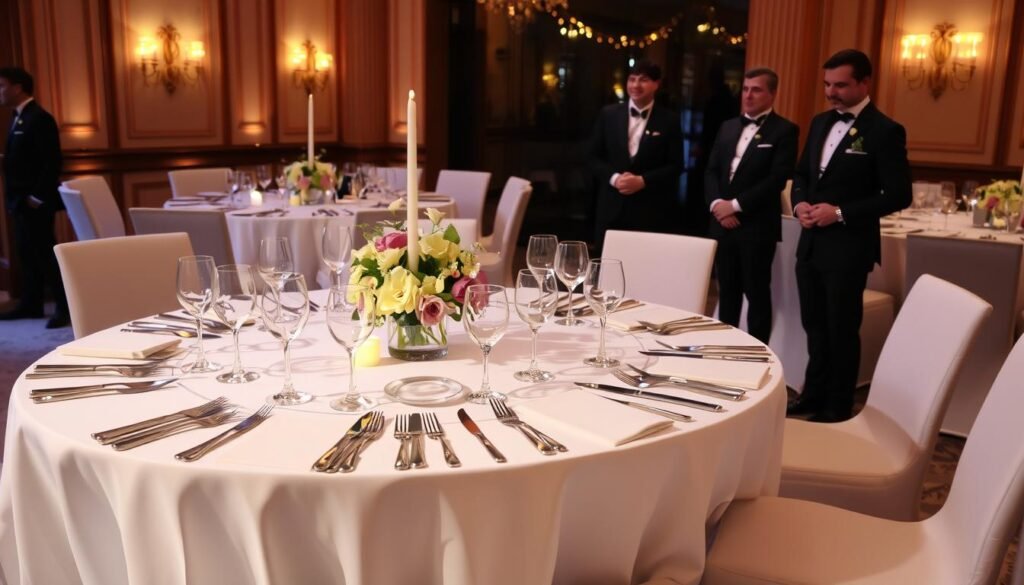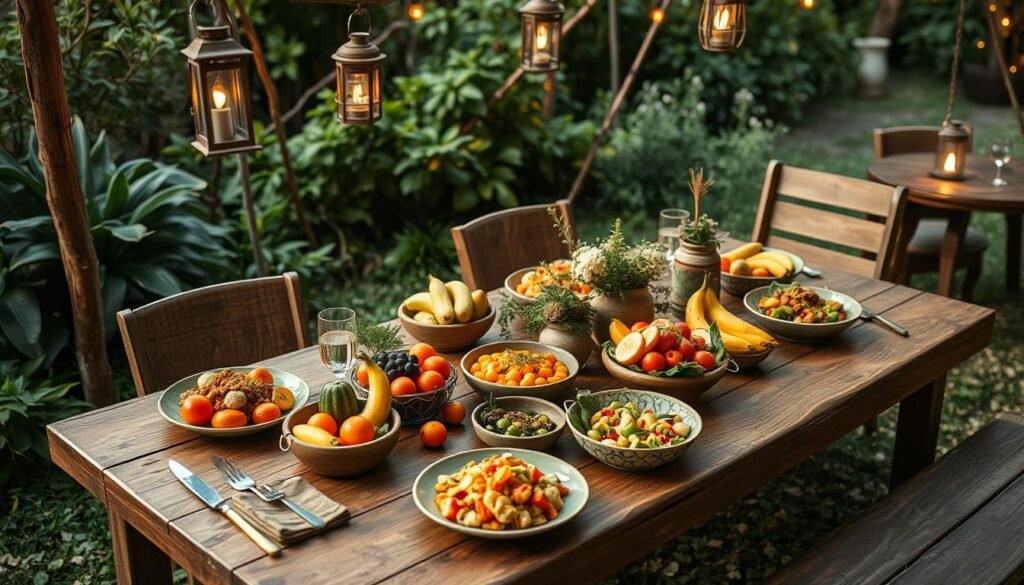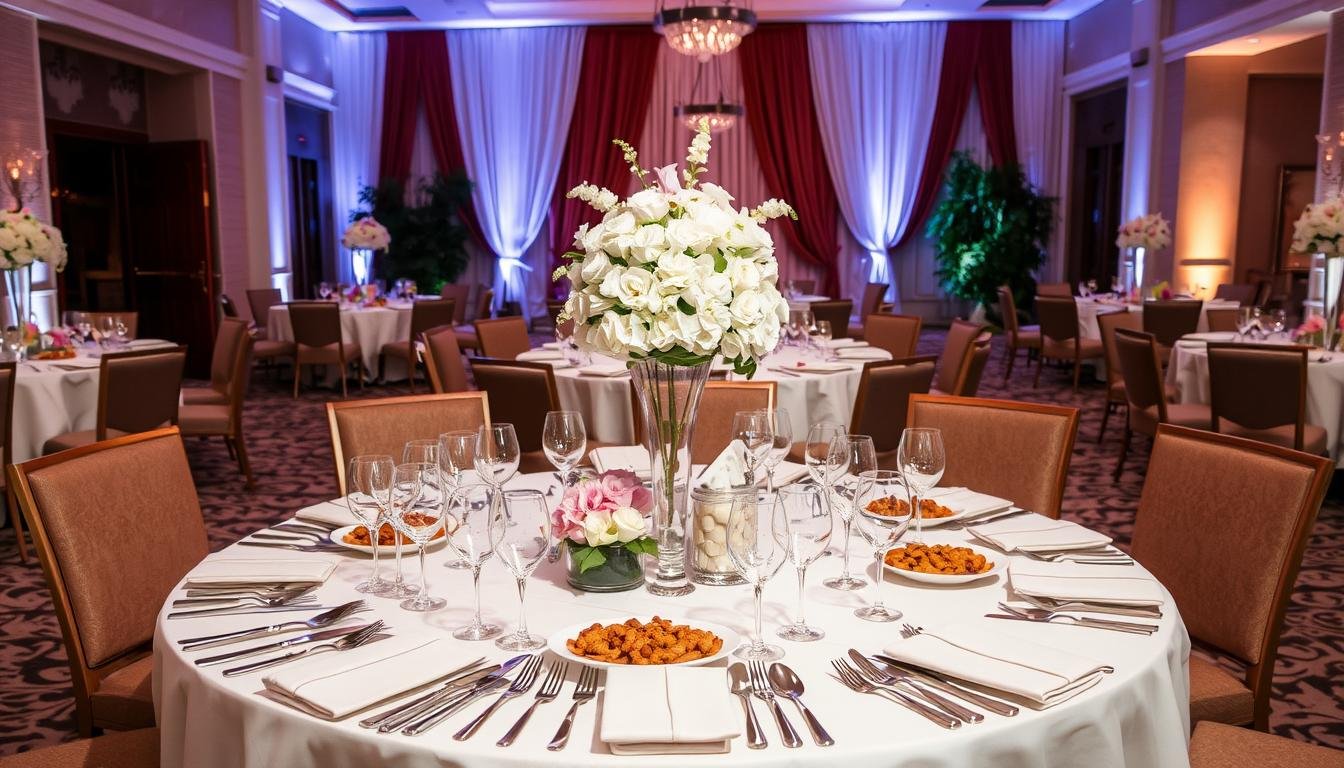Ever ponder the transformative potential of superior dinner catering on a mere gathering? In the realm of event catering, the caliber and aesthetics of the culinary offerings profoundly influence the ambiance of any gathering, be it a corporate conclave or a personal jubilee. Opting for professional catering services allows you to dazzle your attendees with exquisite culinary selections that mirror your aesthetic and the event’s ethos. As we delve into the core aspects of dinner catering, you will uncover how a meticulously crafted menu can not only enhance the dining experience but also forge indelible memories.
Key Takeaways
- Understanding the importance of dinner catering in event planning.
- Discovering how gourmet catering enhances guest experiences.
- The role of professional catering services in setting the tone for events.
- Exploring different menu options for various occasions.
- Learning how to select the right catering service for your needs.
What is Dinner Catering?
Dinner catering offers a bespoke service, dedicated to the preparation and presentation of evening meals for diverse events. It distinguishes itself by providing more substantial fare, contrasting with the lighter options found in other catering services. This approach ensures a meticulously crafted sequence of courses, thereby elevating the dining experience to new heights.
Definition and Explanation
In the realm of event catering, dinner catering emerges as a preferred option. It encompasses a comprehensive meal, encompassing appetizers, main courses, accompaniments, and desserts. This service alleviates the burden of culinary preparation, enabling hosts to present a diverse array of culinary delights to their guests. Such an experience is bound to leave a lasting impression on all attendees.
Differences from Other Catering Types
Dinner catering diverges markedly from its counterparts, such as lunch or cocktail catering, primarily in terms of meal structure and the ambiance it fosters. Lunch catering tends to feature lighter fare or sandwiches, whereas cocktail catering revolves around small, bite-sized appetizers. Conversely, dinner catering is centered around a comprehensive dining experience, comprising multiple courses that encourage guests to savor their meal at leisure.
Why Choose Dinner Catering for Your Event?
Dinner catering emerges as a quintessential solution for hosts intent on crafting an indelible dining experience for their guests. Its unparalleled event versatility enables it to seamlessly integrate with diverse themes, styles, and preferences, rendering it universally applicable. Whether the event is a casual assembly, a formal gala, or a corporate gathering, dinner catering delivers bespoke experiences tailored to fulfill a myriad of requirements.
Versatility for Different Occasions
The hallmark of dinner catering resides in its capacity to accommodate a spectrum of events. This adaptability empowers hosts to meticulously tailor every detail to align with their unique vision. The options range from refined plated meals to vibrant buffet presentations, with no limit to creativity. Moreover, catering to special dietary requirements ensures inclusivity for all attendees. Engaging with seasoned caterers can further refine this versatility, streamlining the event planning process.
Enhancing Guest Experience
A paramount aspect of any successful event is the guest experience. Innovative dining arrangements, such as interactive food stations, can captivate guests and amplify the meal’s enjoyment. Professional caterers, with their meticulous attention to service, curate an environment that prioritizes both comfort and satisfaction. To further enrich the culinary experience, consider incorporating seasonal ingredients to enhance the menu’s flavor profile. For additional inspiration, explore healthy yet delectable options available at delicious healthy meals. A meticulously planned dinner catering experience guarantees lasting memories for all participants.
Popular Dinner Catering Styles
The selection of dinner catering styles is paramount in event planning, significantly influencing the overall ambiance. Each style caters to distinct preferences and settings, enabling hosts to tailor the experience to their gathering’s unique requirements.
Buffet Catering
Buffet catering is a favored option, fostering a relaxed environment. It grants guests the autonomy to choose from a diverse array of dishes, accommodating individual tastes and dietary restrictions. This self-service approach facilitates social interaction and conversation, making it particularly suitable for events such as weddings and corporate gatherings.
Plated Service
Plated service offers a more refined dining experience. Each dish is meticulously prepared and served individually, ensuring synchronized meal delivery to all guests. This method imbues an air of elegance, making it a preferred choice for high-end events where attention to detail is paramount.
Family-Style Dining
Family-style dining merges the essence of buffet catering with the sophistication of plated service. Guests partake in communal dining by sharing large platters of food placed at their tables, thereby fostering a sense of community. This approach is versatile, suiting both casual and formal events, and encourages guests to engage in conversation while enjoying a variety of dishes.
Menu Options: What to Expect
Engaging with a dinner catering service unveils a plethora of menu options, tailored to satisfy diverse palates and preferences. The emphasis on customized menus empowers hosts to curate a culinary journey that resonates deeply with their guests. By leveraging seasonal ingredients, these services not only amplify flavors but also honor local agricultural bounty. Moreover, the provision of dietary accommodations is paramount, ensuring inclusivity and satisfaction for all attendees.
Customized Menus
Customized menus emerge as a hallmark of catering services, allowing hosts to craft menus that reflect the essence of their event. This adaptability enables the incorporation of personal touches, cultural nuances, and guest preferences, thereby guaranteeing a dining experience that is both memorable and unique.
Seasonal Ingredients
The utilization of seasonal ingredients imbues dishes with an unparalleled freshness, significantly enhancing the ambiance of any gathering. These ingredients, renowned for their superior taste and nutritional value, also contribute to the sustainability of the catering service by supporting local farming initiatives.
Dietary Accommodations
In the contemporary catering realm, accommodating diverse dietary needs is a non-negotiable aspect. Renowned catering entities are adept at offering a range of options, including vegetarian, vegan, gluten-free, and allergy-sensitive dishes. This commitment ensures that every guest has access to delectable choices, regardless of their dietary restrictions.
How to Select the Right Catering Service
The selection of a catering service is paramount for the success of any event. The process commences with exhaustive research, necessitating the identification of local caterers whose offerings resonate with your event’s theme and budgetary constraints. Valuable insights can be gleaned from recommendations garnered from acquaintances, as well as perusing online reviews, which offer a glimpse into their past endeavors.
Researching Local Caterers
Initiate your exploration by cataloging local caterers within your vicinity. Refine your list by scrutinizing their specialties, ensuring alignment with your event’s specific requirements. Confirm their availability for your desired event date. Engaging in preliminary consultations is advisable, as it enables an assessment of their responsiveness and genuine interest in your occasion.
Reviewing Portfolios and Menus
Once a list of potential caterers is compiled, scrutinizing their portfolios and menus becomes imperative. This phase allows for an evaluation of their aesthetic, creativity, and culinary prowess. Perusing sample menus unveils the breadth of their offerings, catering to diverse tastes. Engaging in dialogue with the caterers regarding their portfolios elucidates their capacity for customization, aligning with your event’s unique requirements. For a comprehensive guide on selecting the right caterer, refer to this resource, which delves into the critical facets of catering service selection.
Importance of Tasting Sessions
Tasting sessions are a critical component in the orchestration of any dinner catering event. They afford hosts a unique opportunity to interact intimately with the menu, thereby ensuring that the chosen dishes resonate with their event’s ethos. This engagement is pivotal in guaranteeing that the culinary offerings are in harmony with the host’s vision.
Understanding Flavor Profiles
Through tasting sessions, hosts delve into the complex flavor profiles of diverse dishes. This immersion not only permits them to savor the culinary creations but also empowers them to make informed decisions. By familiarizing themselves with these flavor combinations, hosts can bolster their confidence. This is particularly crucial when considering how these flavors will interact with their guests’ palates.
Making Menu Adjustments
Discussions around menu adjustments are a cornerstone of the tasting session. Feedback from the host and potential attendees plays a pivotal role in guiding the caterer in refining the menu. Whether it necessitates tweaking spice levels or substituting ingredients to accommodate dietary restrictions, these modifications can profoundly elevate the event’s overall ambiance. A meticulously curated menu, shaped by these tasting sessions, guarantees that every guest’s preferences are considered, thereby ensuring a memorable experience for all.
Event Planning Tips with Dinner Catering
Effective event planning necessitates meticulous dinner catering coordination. Achieving a seamless experience for your guests hinges on aligning all logistical aspects. Collaborating with your catering team is crucial for grasping the event’s flow and setting realistic expectations.
Coordination with Venue and Timeline
Engaging in discussions regarding the venue’s specifics is paramount. Consider the following elements:
- Arrival Times: Verify the food’s arrival and setup protocols.
- Setup Requirements: Examine the required space, furniture, and equipment for service.
- Tentative Timeline: Develop a comprehensive schedule detailing the event’s progression.
Setting Up a Tasting Schedule
Establishing a tasting schedule is a critical step. It enables clients to sample dishes and communicate their preferences to the caterer. To enhance your tasting experience, consider the following:
- Select a range of menu items to cater to diverse tastes.
- Plan tastings in advance, allowing for necessary adjustments.
- Ensure key decision-makers are present for the tasting to achieve consensus on primary dishes.
Budgeting for Dinner Catering
Formulating a catering budget necessitates consideration of multiple factors, each capable of influencing the overall expenditure of your event. It is imperative to grasp the average costs per attendee, as these can fluctuate based on the menu, service style, and the caterer’s standing. Such comprehension is vital for strategic planning, ensuring that your financial projections are in harmony with the available resources.
Average Costs to Consider
In the process of budgeting for catering, several average costs should be taken into account:
- Menu choices: The selection of dishes can significantly impact the cost. Gourmet options, for example, are generally more expensive than standard dishes.
- Service style: The choice between buffet and plated service can affect costs, with buffet service typically being less expensive due to reduced staff needs.
- Number of guests: The total cost is directly proportional to the number of attendees anticipated.
Hidden Fees and Extras
Many caterers impose hidden fees that can substantially alter your budget. These include:
- Gratuities: Tips for the waitstaff are often added as a service charge.
- Service charges: Some caterers may include a percentage on top of the initial catering costs.
- Rental costs: Expenses for items such as tableware, linens, and equipment are not always included in the initial quote.
It is essential to be aware of these hidden fees. Creating a detailed budget from the outset can prevent unexpected financial burdens. This proactive approach ensures that your event is enjoyed without the stress of unforeseen expenses. For those dealing with legal fees from accidents, insights can be found here.
Enhancing the Dining Experience

The art of crafting an unforgettable dining experience transcends the mere consumption of food. It is deeply intertwined with the ambiance created by the table setting and decor. These elements significantly influence how guests engage with their meal and each other. It is through these thoughtful details that an ordinary dinner can be elevated to an extraordinary event.
Table Setting and Decor
A meticulously planned table setting is instrumental in shaping the overall ambiance. Consideration should be given to:
- Floral arrangements that resonate with the event’s theme
- Elegant table linens that harmonize with the color scheme
- Carefully curated place settings, including decorative chargers and flatware
Each of these elements contributes to a unified aesthetic, transforming the dining space into an inviting and visually stunning environment.
Waitstaff and Service Style
The impact of waitstaff on the dining experience cannot be overstated. Their professionalism and attentiveness foster an atmosphere conducive to guest interactions and relaxation. Various service styles, such as:
- Formal plated service, where courses are served to each guest
- Buffet style, allowing guests to select their portions
- Family-style dining, encouraging shared experiences at the table
Regardless of the chosen style, the training and presentation of the waitstaff are crucial in enhancing the meal’s enjoyment. This leaves guests with a lasting impression.
Catering for Corporate Events
The art of catering for corporate events, encompassing business luncheons and dinners, necessitates meticulous planning to guarantee a refined experience. The selection of a menu that resonates with the corporate ethos is paramount, as it serves to impress attendees and uphold professional standards. It is imperative to offer a variety of options that cater to diverse palates, while also ensuring that dietary restrictions are accommodated to include all guests.
Business Luncheons and Dinners
In the context of business luncheons, the creation of an inviting ambiance is crucial, as it fosters networking and dialogue. The provision of boxed lunches or buffet-style service can offer both convenience and adaptability. Conversely, for more formal dinners, the adoption of plated service imbues an air of sophistication, thereby enhancing the overall ambiance. The utilization of premium ingredients and seasonal flavors can significantly impress both clients and colleagues.
Team-Building Activities with Food
Food’s role in team-building activities is profound, transforming meals into platforms for collaboration. Engaging in culinary challenges or cooking classes enables team members to forge bonds while crafting delectable dishes. These interactive endeavors cultivate teamwork and creativity, thereby strengthening workplace relationships. The integration of food into professional development initiatives can significantly elevate the office environment.
Catering for Weddings
Weddings offer a unique chance to craft memorable culinary experiences. The process of wedding catering involves meticulous planning and execution, particularly when orchestrating multiple courses. A meticulously structured meal not only captivates guests but also elevates the celebration’s ambiance. Engaging a professional catering service ensures the timeline and presentation harmonize with the couple’s vision.
Managing Multiple Courses
Organizing wedding catering necessitates careful consideration of how multiple courses will transition seamlessly. A standard wedding meal might begin with appetizers, proceed to salads, then main courses, and finally conclude with desserts. A seasoned catering team can offer insights on the optimal sequence and timing for each dish, thereby enriching the dining experience. Effective planning is further facilitated by discussing plating styles and serving methods that resonate with the couple’s theme and preferences.
Personalizing the Menu for Couples
A personalized menu presents an opportunity to mirror the couple’s tastes and heritage. Couples often cherish the chance to incorporate cultural dishes or family favorites, thereby creating a distinctive experience for their guests. Engaging in dialogue with the catering service allows couples to curate a menu that encapsulates their narrative. For further insights into crafting the ideal meal, explore wedding catering options specifically designed for your occasion.
Eco-Friendly Dinner Catering Options

The surge in demand for environmentally conscious catering has prompted hosts to seek out eco-friendly alternatives. This shift not only caters to the gastronomic preferences of guests but also resonates with the ethos of sustainability and responsible consumption. We will examine two pivotal elements of eco-friendly dinner catering: the utilization of sustainable ingredients and the adoption of zero-waste practices.
Sustainable Ingredients
Choosing sustainable ingredients is a fundamental aspect of eco-friendly catering. The selection of locally sourced produce and organic meats not only diminishes carbon footprints but also elevates the gastronomic experience at events. The advantages of sustainable ingredients are multifaceted:
- Support for local farmers and businesses
- Fresher and tastier food options
- Reduced environmental impact
Zero-Waste Practices
Adopting zero-waste practices is crucial for minimizing environmental impact during events. Thoughtful portion control aids in reducing food waste, while composting leftovers enriches soil and fosters sustainability. Furthermore, the utilization of biodegradable materials for serving supports eco-friendly initiatives. Key strategies include:
- Preparing meals that can be fully utilized, leaving minimal waste
- Educating guests on proper disposal of biodegradable items
- Collaborating with caterers experienced in zero-waste practices
Client Testimonials: What to Look For
In the realm of selecting a dinner catering service, the scrutiny of catering client testimonials emerges as a pivotal factor. These evaluations offer a glimpse into the experiences of prior patrons, underscoring the caliber of the culinary offerings, service delivery, and overall client satisfaction. The discernment of what previous clients have lauded facilitates a more informed decision-making process.
Importance of Customer Reviews
Customer reviews act as a beacon of reliability for a catering service. They often highlight specific elements that resonate, such as the aesthetic presentation of dishes or the demeanor of the staff. Seek out positive experiences that underscore pivotal moments, ensuring the caterer’s alignment with your expectations. Utilizing review platforms can expedite your quest for credible testimonials.
Sharing Positive Experiences
The cultivation of a culture where clients are encouraged to share their experiences fosters a bond of trust with prospective patrons. These catering client testimonials not only bolster the confidence of future clients but also enhance the catering establishment’s standing. The celebration of positive experiences elevates team morale and resonates with incoming clients. Delving into past reviews reveals the caterer’s dedication to excellence and customer service. Explore catering review sites to broaden your comprehension of the caterer’s influence.
Next Steps After Choosing a Catering Service
Upon selecting a catering service, the focus transitions to finalizing details essential for a seamless event. This critical phase ensures that all culinary aspects meet the anticipated standards.
Finalizing the Details
Initiate by thoroughly examining the menu, encompassing service style and timeline. Investigate any special requests that could elevate the guest experience. Detail the critical components such as:
- Menu selections
- Service style preferences (buffet, plated, etc.)
- Guest count verification
- Setup and breakdown times
- Special dietary needs
Communicating with Your Caterer
Effective communication is paramount for a successful catering experience. Designate a clear point of contact with the catering service to facilitate seamless interactions. Regular updates are imperative, confirming vital details as the event draws near. This proactive stance not only accommodates any last-minute adjustments but also cultivates a trusting relationship. Through collaborative efforts, adjustments can be made, ensuring that expectations are fulfilled, leading to a memorable occasion.
Conclusion: Making Your Event Memorable
The essence of a memorable event lies in the effective execution of dinner catering. This begins with the selection of a caterer who grasps your vision and preferences. Customizing the menu to align with your event’s theme is crucial, ensuring each dish captivates your guests.
Recap of Key Considerations
Enhancing the dining experience through meticulous service and exquisite decor is equally vital. Attention to detail can elevate a simple meal into a profound culinary adventure. By dedicating time and effort to these elements, hosts can forge a dining atmosphere that resonates deeply with attendees, leaving an indelible mark in their memories.
Final Thoughts on Dinner Catering
Dinner catering transcends mere sustenance, offering an experience that etches itself into the collective memory. By meticulously considering each aspect, from menu choices to ambiance, your event will undoubtedly stand out. Guests will depart feeling not only satiated but also cherished. Seize this opportunity to elevate your gathering through superior dinner catering, ensuring it becomes an event to be etched in memory.
FAQ
What types of events can benefit from dinner catering?
Dinner catering is a versatile option for a myriad of events, encompassing corporate gatherings, nuptial celebrations, gala dinners, and intimate private parties. Catering professionals adeptly tailor their offerings to meet the unique demands of each occasion, guaranteeing a memorable gastronomic experience for attendees.
How do I choose the right catering service for my event?
In the selection of a catering service, it is crucial to evaluate the local caterers’ reputations. Review their portfolios and menus to gauge their culinary expertise. Assess their responsiveness and professionalism, ensuring a seamless collaboration. Clear communication of your expectations is paramount for a successful partnership.
Can I customize the menu with my dinner catering service?
Indeed, many catering services offer bespoke menus, accommodating your preferences, cultural inclinations, and dietary requirements. This customization ensures that your guests partake in an inclusive and enjoyable dining experience.
What are the different styles of dinner catering available?
Several dinner catering styles are prevalent, including buffet catering, where guests serve themselves; plated service, offering a formal dining experience with courses served to each guest; and family-style dining, which fosters communal meal sharing.
How can I ensure dietary restrictions are met at my event?
It is imperative to discuss dietary accommodations with your caterer in advance. Reputable catering services possess the knowledge and capability to create menus that cater to a variety of dietary needs, including vegetarian, vegan, gluten-free, and allergy-sensitive options.
What is the importance of tasting sessions?
Tasting sessions are indispensable, allowing hosts to sample flavors and dishes prior to the event. This step is crucial for refining the menu based on personal preferences and guests’ feedback, ensuring that the final selection resonates with the event’s theme and ambiance.
What should I include in my catering budget?
When crafting a catering budget, consider average costs per person, menu selections, service styles, and any additional hidden fees such as gratuities, service charges, or equipment rentals. A comprehensive budgeting approach helps mitigate unexpected expenses.
How can I enhance the dining experience for my guests?
To elevate the dining experience, focus on thoughtful table settings and decor that harmonize with the event’s theme. Additionally, ensure the presence of professional waitstaff who provide attentive service. These elements significantly contribute to guest satisfaction and the overall ambiance of the event.
Can catering services help with corporate events?
Indeed, catering services are adept at catering to corporate events, offering tailored menus that align with business settings, such as business luncheons and dinners. They can also facilitate unique team-building activities centered around food, fostering collaboration and camaraderie among participants.
Are there eco-friendly catering options available?
Many catering services now provide eco-friendly options, utilizing sustainable ingredients and implementing zero-waste practices. This approach enables hosts to minimize their environmental footprint while catering to guests who prioritize sustainable consumption.
What role do client testimonials play in choosing a catering service?
Evaluating client testimonials is crucial, as they offer insights into previous clients’ experiences with food quality and service. Positive reviews often highlight specific aspects of the catering service, instilling trust and confidence in your selection.
What are the next steps after choosing a catering service?
Following the selection of a catering service, it is essential to finalize details such as the menu, service style, and timeline. Maintain effective communication with your caterer to ensure clarity on expectations and address any last-minute changes efficiently.

